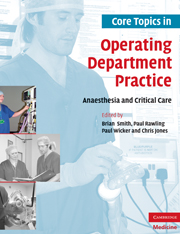Book contents
- Frontmatter
- Contents
- Acknowledgements
- List of Contributors
- Foreword
- Preface
- 1 Introduction: anaesthetic practice. Past and present
- 2 Risk assessment
- 3 ECG monitoring in the recovery area
- 4 The use of cricoid pressure during anaesthesia
- 5 Anaesthetic breathing circuits
- 6 Deflating the endotracheal tube pilot cuff
- 7 How aware are you? Inadvertent awareness under anaesthesia
- 8 Aspects of perioperative neuroscience practice
- 9 Resuscitation
- 10 Intravenous induction versus inhalation induction for general anaesthesia in paediatrics
- 11 Managing difficult intubations
- 12 Obstetric anaesthesia
- 13 Understanding blood gases
- 14 Total intravenous anaesthesia
- 15 Anaesthesia and electro-convulsive therapy
- 16 Mechanical ventilation of the patient
- 17 Perioperative myocardial infarction
- 18 Developing a portfolio
- 19 Accountability in perioperative practice
- Index
- References
2 - Risk assessment
Published online by Cambridge University Press: 13 August 2009
- Frontmatter
- Contents
- Acknowledgements
- List of Contributors
- Foreword
- Preface
- 1 Introduction: anaesthetic practice. Past and present
- 2 Risk assessment
- 3 ECG monitoring in the recovery area
- 4 The use of cricoid pressure during anaesthesia
- 5 Anaesthetic breathing circuits
- 6 Deflating the endotracheal tube pilot cuff
- 7 How aware are you? Inadvertent awareness under anaesthesia
- 8 Aspects of perioperative neuroscience practice
- 9 Resuscitation
- 10 Intravenous induction versus inhalation induction for general anaesthesia in paediatrics
- 11 Managing difficult intubations
- 12 Obstetric anaesthesia
- 13 Understanding blood gases
- 14 Total intravenous anaesthesia
- 15 Anaesthesia and electro-convulsive therapy
- 16 Mechanical ventilation of the patient
- 17 Perioperative myocardial infarction
- 18 Developing a portfolio
- 19 Accountability in perioperative practice
- Index
- References
Summary
Key learning points
Identification of hazards in the perioperative environment
The principles of risk assessment
Measures which practitioners can take to reduce risk
Carrying out risk assessment
Few practitioners see the topic of health and safety as being relevant or interesting until they start to consider it in depth. As they explore the topic, the individual's anxiety heightens as the awareness of safe and unsafe practices grows. The reality is that any practitioner could, by act or omission, become involved in a critical incident. This awareness is especially important in the perioperative environment which by its nature is dangerous and full of many hazards which can harm patients or staff.
The motivating reasons that influence a practitioner's behaviour towards health and safety can be identified as:
moral
legal
economic
employment
professional.
Moral reasons
It should be enough for all practitioners to always apply the principles of risk reduction and good adherence to health and safety practices, just because this is a moral responsibility to others. Nevertheless, if this is not reason enough to motivate practitioners, there is a wealth of health and safety legislation associated with the subject. As with any other Act, a breach of named regulations could result in the individual and/or the organisation receiving an enforceable punishment.
Legal reasons
Interestingly enough, most practitioners are aware of ‘The Health and Safety at Work Act, 1974’ (HSAWA). Why then, if perioperative practitioners have an awareness of their legal responsibilities about health and safety, do they often adopt seemingly complacent attitudes towards it?
Information
- Type
- Chapter
- Information
- Core Topics in Operating Department PracticeAnaesthesia and Critical Care, pp. 8 - 16Publisher: Cambridge University PressPrint publication year: 2007
